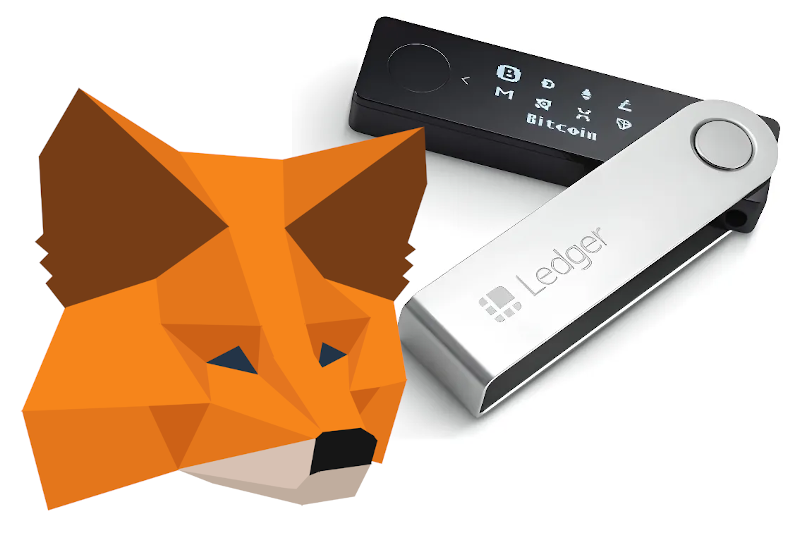At the moment, one of the most well-known blockchains is Ethereum, which has gained popularity due to its reliability, speed, and the opportunities it provides. Many users have chosen the MetaMask Ethereum wallet for storing cryptocurrency because it is quick to install and easy to use. It also provides free and convenient access to decentralized applications known as DApps and decentralized finance services – DeFi for short.
However, it is important to think about the safety and security of your funds, regardless of whether it is cash, debit card money or cryptocurrency. If you have chosen the MetaMask Ethereum wallet for storing cryptocurrency, it seems only logical to wonder: is MetaMask secure?
In this article, we will take an in-depth look at MetaMask security. First, we will remind you what a MetaMask wallet extension is, how it is being used, and how it works; and then we will consider whether MetaMask is safe.
What is a MetaMask wallet?
MetaMask Ethereum wallet is a free browser extension and mobile application created by ConsenSys Software Inc. MetaMask wallet extension can be installed for Chromium-based browsers such as Chrome, Firefox, and Opera. The MetaMask Ethereum wallet mobile app was released in September 2020 for iOS and Android. It allows you to use the capabilities of the wallet from anywhere in the world.The MetaMask wallet extension and app allow you to manage Ether cryptocurrency (ETH) and tokens based on the ERC-20 and ERC-721 standards. You may store, receive, send, exchange, and buy Ether or any popular tokens such as USDT or NFT Stablecoins. You may also connect the Binance Smart Chain network to manage BEP-20 crypto-assets and quickly switch between networks with the push of a button.
Apart from Ethereum and Binance Smart Chain, the MetaMask wallet extension is able to work with any other Ethereum Virtual Machine (EVM) compatible blockchain. EVM is a distributed virtual machine that is an integral part of the Ethereum blockchain. It allows the blockchain to be not just a payment system, like Bitcoin, but a full-fledged platform for creating decentralized applications. Ethereum provides blockchain development services in the form of smart contracts, which are programs written in Solidity. They allow the creation of autonomous secure contracts that do not require a third trusted party and are executed automatically when programmed conditions are met. They are stored in a publicly accessible blockchain in EVM data. It allows smart contracts to be reused when the logic programmed into them is needed, so you don’t have to create a new one each time.

MetaMask security provides comfortable usage of the wallet functionality.
MetaMask wallet extension and mobile applications also have a new built-in feature that helps simplify the process of exchanging crypto assets. MetaMask Swaps collects actual data from decentralized aggregators of offers for exchanging tokens and cryptocurrencies and decentralized exchangers (DEX), which allows for choosing the most favorable exchange rate. With Swaps, the user can exchange tokens directly from MetaMask on the most popular exchanges, such as Uniswap, Paraswap, Airswap, Curve, 1inch, and others. In addition, MetaMask security takes care of user data protection and provides DAX and DApps only the required minimum, for example, only the foreign key. It makes MetaMask safe for performing various transactions during the token exchange.These articles about dApps may also be interesting for you:
1) How to Build a Decentralized App? And Why…
2) What Is a DApp: How Do You Make an App That Nobody Owns and Brings YOU Profit?
ConsenSys also took care of entrepreneurs by creating a new wallet version for them. But what is a MetaMask wallet for business? MetaMask Institutional, a DeFi wallet and Web3 gateway for organizations, appeared in the spring of 2021. It allows you to manage key storage and interact with over 17,000 DeFi protocols and applications. It also facilitates the approval of multi-signature transactions and optimizes trade flows by integrating with a selected qualified custodian or custodial provider. In addition, built-in MetaMask security features secure transactions with pseudonymous counterparties with pre- and post-trade KYT risk assessment on smart contract addresses and DeFi pools.
Blockchain stores data on wallet addresses and balances, and transactions made. To access a cryptocurrency wallet and manage its contents, you need to have private and public keys. The purpose of these keys is to confirm transactions. MetaMask stores these keys on the user’s device in encrypted form. When the user wants to perform a transaction, for example, the purchase of a service in a Web 3.0 application, MetaMask immediately connects to the decentralized application as soon as you press the appropriate button in the application. Then, MetaMask signs the transaction and sends it to the blockchain on the user’s computer or mobile device. It happens since the wallet is non-custodial and does not store users’ keys on its side, giving the user full control over their own assets. However, storing user data in a local browser or app memory makes the wallet hot and raises questions about MetaMask security.
If you have any additional questions, such as what a MetaMask wallet is and if MetaMask is secure, please contact us. At Brivian, we can answer your questions based on our extensive experience in providing cybersecurity and blockchain development services. To contact us, leave a request either at the end of the article or here.
Security and cryptocurrencies
Blockchain opens up a lot of opportunities for people in the new decentralized, free, and anonymous world of crypto technology. You only need an Internet connection to access this world. However, with great freedom and anonymity come great security problems. Because of the popularity of crypto and the large amount of money that blockchain opportunities attract, hackers do not miss a single opportunity to make money illegally from technology vulnerabilities and user carelessness.Hackers use every possible means to steal other people’s property. They create fake sites, which are full copies of popular Web 3.0 network services, where a user may inattentively transfer cryptocurrency to an attacker’s account. Moreover, malefactors can simply steal records with passwords and private keys. In addition to this, there are many other methods. Therefore, it is especially important to protect yourself as much as possible from attacks to avoid vulnerabilities in storing and using cryptocurrency. To do this, you need to know about the main types of wallets.
To begin with, it is worth recalling that the wallets do not store the cryptocurrency itself but only the private and public keys. Cryptocurrency in the form of information encrypted in a chain of blocks is stored in a blockchain network. As an analogy, a plastic bank card does not directly store money but only the information needed to access the bank account.
So, let’s look at the division into hot and cold wallets. Actually, it’s pretty simple: cold wallets are all wallets that store keys without an Internet connection. Such wallets are examples of removable drives and even a paper note. Hackers cannot access the data stored in such a wallet over the Internet. Hot wallets are those that are connected to the World Wide Web. Such wallets are any apps, sites, and browser extensions.
Wallets are also divided into hardware wallets, paper wallets, and software wallets. Hardware wallets are referred to as cold wallets. Most often, hardware wallets are made in the form of a USB drive that stores keys. Transactions require connecting the device to a computer. Often, more advanced versions have built-in passphrases or fingerprint locks. This type of wallet is convenient for those who do not need to make quick and frequent transactions. Besides, they are most protected from hacker attacks, since the keys are stored offline in removable carriers. The most popular manufacturers of hardware wallets are Ledger and Trezor.
Paper wallets are cards or bills with seed phrases, private and public keys, and QR keys for quick data access printed on them. Such wallets are also a type of cold wallet. Such a QR code can be generated using special software. The paper wallet can then be stored in a wallet or in a safe deposit box. However, even cold hardware or paper wallets can be hacked, just not offline, but online. They can be stolen along with your bag or wallet, or in the most unpleasant of circumstances, robbed by forcing you to reveal code phrases.
Software wallets are hot crypto wallets in the form of mobile, desktop, and web applications. They have a permanent connection to the Internet and store key data in local storage locations. Such wallets are less secure against online hacking attacks, such as gaining access to computer memory with malware. However, they do provide a higher speed of transaction signing, which can come in handy for users who trade on exchanges.
In addition, wallets are divided into custodial and non-custodial wallets. Custodial wallets store your keys on their own servers, and users access them with an account. Most commonly, custodial wallets can be found on decentralized exchanges that provide services for buying and exchanging crypto assets. The beneficial factor in choosing such a wallet can be the high speed of transactions. Unfortunately, however, custodial wallets can limit a user’s choice of asset purchase or exchange offers. They force transactions at the prices offered inside their server. Scam projects, on the other hand, may not allow you to withdraw funds from the wallet at all. Also, custodial wallet servers can be subjected to cyber-attack, which may lead both to rendering the service inoperable and to loss of data and funds. This happens because the user has no control over the keys.
Non-custodial wallets, on the contrary, do not store the user’s key data on their side. It provides the user with full control over the keys and funds but imposes the need to handle the security of the assets themselves.
As you have probably already guessed, MetaMask is a hot software non-custodial cryptocurrency wallet. Thus, we can imagine the possible vulnerabilities in this wallet. In fact, users often have questions about MetaMask security. Often you can even find discussions on specialized forums with questions like “Is MetaMask secure?” or “Is MetaMask safe?”. Let’s get to the bottom of this.
Is MetaMask secure?
MetaMask, like any software, cannot be one hundred percent secure. It is developed by people, and people tend to make mistakes and not be able to calculate all the possible options for unauthorized access to important elements of the system. As a result, there are security weaknesses in an application or extension of the MetaMask. However, the greatest risk is exposed not MetaMask software itself but the users.The main vulnerabilities can be divided into two main groups: vulnerabilities on the side of MetaMask and its technical features, and vulnerabilities on the side of the user.
MetaMask information security can be compromised due to hacker attacks aimed at disabling critical nodes in the service architecture and obtaining unauthorized access to the information stored on the servers. As a result, ordinary users may encounter errors in transactions, loss of access to wallet services, or data loss altogether. Fortunately, so far there is no news about successful attacks of this kind. Thus, we can assume that ConsenSys has a high level of MetaMask security.

User data are reliably protected from hacker attacks with MetaMask security.
Information security breaches might also occur if hackers successfully gain control of the blockchain network. This requires more than 70 percent of blockchain nodes to be compromised by hackers to be able to modify data for their own benefit. However, as we know, the Ethereum blockchain network operates a large number of nodes, roughly ten thousand. All of these nodes are controlled by different companies and enthusiasts. It leads us to believe that blockchain hacking is highly unlikely to happen.However, the biggest risk is storing private and public keys in the local data storage of the browser or app. Hackers can attack the browser or app by various means and gain access to the data stored in the device’s memory.
MetaMask performance can also be affected by its features of working on external nodes of the blockchain network, instead of maintaining its own nodes. This system of nodes for various blockchain-based applications is called Infura. If this system is attacked or experiences performance problems, MetaMask users may have problems with connection and the use of MetaMask functionality. Luckily, there have been no problems with Infura functionality to this point. However, in some countries, users may need to use a VPN or change addresses in their wallet network settings due to the fact that Infura has been forced to comply with sanctions requirements.
On the user side, we can highlight the dangers of storing keys and crypto-assets, many of which are based on carelessness and lack of information. Most of the risks come from fake sites and applications. They may ask for excessive memory access permissions or, acting under the guise of the original MetaMask services, require the entry of seed phrases. Third-party unlicensed software, which may contain malicious code, may also pose a threat. There are also kinds of social engineering scams, when criminals pretend to be MetaMask security employees, in order to find out your private key or seed phrases. Moreover, there are fake tokens, which can be transferred to your account instead of real tokens.
Tips for making MetaMask safe
Consequently, we can conclude that most of the dangers associated with MetaMask security could be avoided with care and caution. A few simple tips are worth following in order to do this:- Keep your private key and seed phrases as secure as possible. Do not share them with anyone under any circumstances. If you lose your private key, you can restore it with the seed phrases. Therefore, the only situation when you can safely enter it is when you restore the private key using the MetaMask security service in the official extension or app.
- Download and install MetaMask extension or application only from official sources. There is only one official MetaMask website, which can be found here. With the help of this site, you can find all the necessary information about how to install MetaMask on your device.
- Do not use your wallet on public devices or when connected to insecure networks.
- Do not leave an extension or application on when you are not using it.
- Use hard-to-guess passwords to access your wallet. Do not create a password from simple combinations and personal information.
- It is advisable to keep open only the tab where you perform the transaction. It will help to prevent intruders from gaining access to your wallet.
- Watch out for enabled extensions and granted permissions for sites and applications. Some extensions and applications may contain spyware that can steal your personal information, including passwords, private keys, and seed phrases.
- Check the smart contract addresses of decentralized applications using official exchange websites and blockchain explore platforms like Etherscan.

You can achieve maximum safety of your crypto-assets by using the Ledger or Trezor hardware wallet option provided by MetaMask security.
Besides, you may be able to avoid possible loss of key data by connecting your wallet to Ledger or Trezor in order to improve MetaMask security as much as possible. In this case, the software MetaMask wallet will act as an external interface for connecting to the blockchain, DApps, and DeFi, and the hardware wallet will keep your keys safe. At the moment, this is almost a hundred percent guarantee of your crypto-assets security.Conclusion
To sum this article up, let’s run through the main points. MetaMask is an extremely popular hot non-custodial cryptocurrency software. ConsenSys developer company maintains MetaMask security at a high level by promptly fixing emerging vulnerabilities. In addition, in order to make your MetaMask wallet finally safe, it is possible to connect it to a hardware wallet. However, even that kind of wallet use may not be safe if your private key or seed phrase is compromised. Keep your secret data as inaccessible as possible and do not share it with anyone, even if intruders try to pass themselves off as MetaMask security employees.If you or your business needs help with MetaMask security or blockchain development services, Brivian is happy to help. Our company has extensive experience in software development for mobile, desktop, and web working with Ethereum, Binance, and Tron blockchains. You can cantuct us here. We’re always glad to answer any questions.